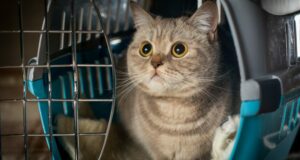 Sometimes in looking at our sweet, lazy house cats we can forget that they are skilled predators under all that fluff. Before we embraced them as constant companions they were used for their prowess at ridding food stores of rodents that would otherwise decimate and contaminate the surplus. But while today’s domesticated felines may catch and consume the occasional bird or mouse, the majority of their diet and nutritional needs are in our hands. What foods offer the best nutrition for cats and how do you choose/supplement thier diet to ensure the best for your pet?
Sometimes in looking at our sweet, lazy house cats we can forget that they are skilled predators under all that fluff. Before we embraced them as constant companions they were used for their prowess at ridding food stores of rodents that would otherwise decimate and contaminate the surplus. But while today’s domesticated felines may catch and consume the occasional bird or mouse, the majority of their diet and nutritional needs are in our hands. What foods offer the best nutrition for cats and how do you choose/supplement thier diet to ensure the best for your pet?
Let’s begin with commercial foods. What are the main differences between low end and high end diets? Should you feed wet or dry? First of all, understand that cats are CARNIVORES. They primarily need quality animal protien for proper health and maintenance. When looking at different commercial foods, search for those that offer high protein content and be sure to inspect where the protein comes from. A real meat protein source should be listed as the first in gredient on the package. Good sources might be chicken, turkey or fish, not these ingredients in the form of “by-products” or “by-product meal”. If possible, feed a grain-free diet. Foods containing no grains as filler are most likely to have the right ratio of protien and carbohydrate. Cats also need a food with supplemental Taurine, and amino acid vital to eye health, cardio health and other systems. They are unable to synthesize enough of this necessary amino acid, so they need it in their diet.
The foods that offer these criteria are on the higher end of the price spectrum because they utilize quality muscle instead of “by-products” like bone, fat, organs and other poor quality ingredients. Higher end foods also tend to use little or no grain as fillers. Ideally, cat food should offer only 3-5 percent carbohydrate, but aim for a diet that contains less than 10 percent. Your cat may love a lower end food, but over time consuming the higher carb levels in these foods (which may use corn, wheat, soy or other fillers in high amounts) can cause serious health issues to develop. High carb, high fat content and low quality protein formulas can lead to gastrointestinal and urinary tract issues, kidney conditions, feline diabetes, obesity and other disorders. Low end foods also influence the quality of your cat’s skin and coat, so his coat may not be as shiny and heavy shedding or skin conditions may result.
What about wet food vs. dry? Some cat owners prefer the convenience and tidiness of a kibble only diet, but increasingly veterinarians are encouraging the switch to wet food as the staple diet. One of the biggest benefits of an all-wet-food diet–the moisture. Cats do not have the drive to consume water like most other pets. This lack of drive can be attributed to the desert origins of the species. In a wild habitat, most of the moisture cats consume comes naturally in the tissue of the prey items they kill and consume. In the home they may drink water from a bowl, but probably not as much as they should. Wet foods provide the additional hydration they need for urinary tract and overall health. Cats that are fed wet food consume about twice as much moisture as those on dry kibble. Wet food formulas also tend to have a better ratio of quality animal protein/fat/carbs, but you should always check the label for the protein source and other relevant info before you decide on which brand to purchase.
Some owners are opting to make their own cat food with natural, fresh or raw ingredients. If this is an option for you, be sure to research ways to vary their intake and be sure that you include supplemental moisture and vitamins for a balanced diet.
 What about treats? There are hundreds of commercial treats on today’s market formulated just for felines. In general, treats should be given only on moderation as the supplemental calories may contribute to obesity if handed out freely. When choosing treats for your pet, use the same considerations you do when choosing food. Avoid carb-based treats and opt for those higher in protein. Some of our favorites are bonito tuna flakes and freeze-dried fish or liver nuggets. You can offer small quantities of fresh fish or meat if your can will take them (some cats will not take to raw items). Some commercial treats offer added vitamins or other benefits like dental cleaning–these are also great to offer once or twice a week. You may prefer natural treats such as fresh catnip or cat grass periodically. Your can will appreciate these offerings as much to rub on as to eat!
What about treats? There are hundreds of commercial treats on today’s market formulated just for felines. In general, treats should be given only on moderation as the supplemental calories may contribute to obesity if handed out freely. When choosing treats for your pet, use the same considerations you do when choosing food. Avoid carb-based treats and opt for those higher in protein. Some of our favorites are bonito tuna flakes and freeze-dried fish or liver nuggets. You can offer small quantities of fresh fish or meat if your can will take them (some cats will not take to raw items). Some commercial treats offer added vitamins or other benefits like dental cleaning–these are also great to offer once or twice a week. You may prefer natural treats such as fresh catnip or cat grass periodically. Your can will appreciate these offerings as much to rub on as to eat!
You may be tempted to offer a dish of milk. Many cats are lactose intolerant, and may show signs of gastric upset if they consume dairy.
Cats eating image referenced from wikipedia and originally posted by Zeemeeuw
 That Pet Blog That Pet Place Pet Blog
That Pet Blog That Pet Place Pet Blog



Well thanks for your post its really useful is that really work for my cat coat to make smoother.
I have recently started a web site, the info you offer on this website has helped me tremendously. Also it has excellent and very informative. After going through this great content i came to know lots of things which will help me to enrich my knowledge.